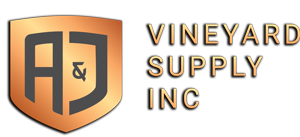Trellis Construction 101: Building a Basic Winegrape Trellis

There are several options available to grape growers and vineyard managers when considering which trellis configuration and which training system to use. This blog explores the basic requirements for wine trellis construction, explaining the tools and supplies necessary for an effective trellis system, no matter what configuration is chosen.
Why We Use a Winegrape Trellis
As you know, grapes naturally grow up towards the sun, pushing their way to the highest point where they can steal the most available sunlight. However, the task of harvesting grapes would be a nightmare if we just let the vines run free. Instead, a Wine Grape Trellis System helps control these far-reaching vines to make it easier to harvest the fruit. The key is to maximize the performance of a grapevine by balancing the amount of fruit development with the amount of energy-producing parts of the vine.
Trellis and Training System Construction: Tools & Materials
A basic winegrape trellis consists of 4 main parts: End posts, in-line stakes, training stakes, and wire. The end posts are the longest and most substantial of the main components, generally ranging from 8’ to 10’ in length. With one end of the post buried several feet underground, the end posts serve to anchor the vine rows at each end and therefore provide the start and end of the row as well as the general trajectory, with the full length of each row equaling the distance between the end posts.
In-line stakes, typically 7’ to 8’ in length, serve as intermediate supports along the vine row. Less substantial in height and weight than the end posts, yet still sturdy enough to support the weight of numerous vines on either side, once installed the in-line stake establishes the approximate trellised height of the mature vineyard as well as providing a point of attachment for the drip, cordon, and canopy management wires.
Training stakes are significantly shorter (typically 4’ to 5’) and lighter and are installed at equal distances between the end posts, adjacent to each vine. As their name would suggest, they are required in a new vineyard to serve as a guide for young vines, helping to ensure that their initial growth is straight and supported. This is accomplished by tying the new growth to the training stake using any number of different tying methods and materials. A vine protector or “grow tube” may also be placed around the new vine and secured to the training stake to provide additional protection from weather and/or critters who might want to feed on tender leaves. Finally, the training stake also serves as an additional attachment point for drip and fruiting wires.
Vineyard wire is the last of the main components that make up a winegrape trellis. The majority of commercial growers in the United States use hi-tensile, galvanized wire to support and manage their vines within the trellis. Different gauges or thicknesses of wire, typically between 10 – 14, provide different levels of support and different adaptability to certain tasks. The heaviest wire is generally used as the cordon or fruiting wire to support the branches that will bear the heavy, mature grape clusters. Growers who want to suspend their drip line off the ground and keep it from sagging throughout the row commonly use the lightest gauge wire to accomplish this task. Intermediate thicknesses are often used in pairs as moveable catch wires to “catch” and trap the vine’s foliage between the wires. The wires are then moved up the in-line stake as the vines’ shoots become longer. Vineyard wire is sold in smaller coils of 100 pounds each or in longer, continuous coils ranging from 500 – 2,000 pounds per coil. These longer coils make working in very long vineyard rows more efficient.
Winegrape Trellis Styles
In today’s viticultural environment, there are many different styles of trellis. Growers and vineyard managers often debate which system is the best or most effective. Many adaptations can be made to accommodate the needs of different varietals, the orientation of the rows, the percentage of the slope of the vineyard, and numerous other unique conditions. But no matter what style of trellis system you choose, it will likely include the four basic elements described above. And if properly maintained, it will certainly result in higher yields and better-quality fruit than your non-trellised neighbors.
A&J Vineyard Supply Can Help
At A&J Vineyard Supply we carry a full line of end posts, in-line stakes, training stakes, and wire. Need to place an order? Contact us here or give us a call at 707-963-5354.
